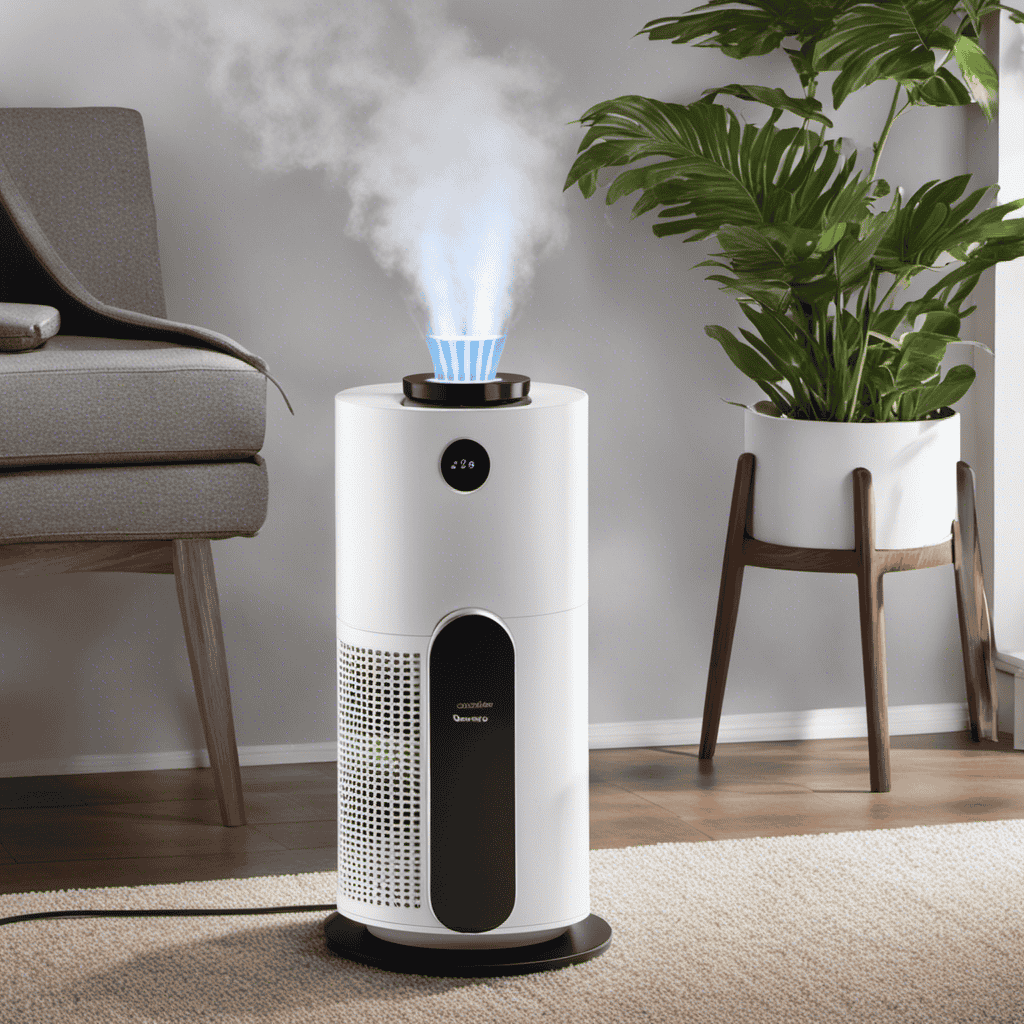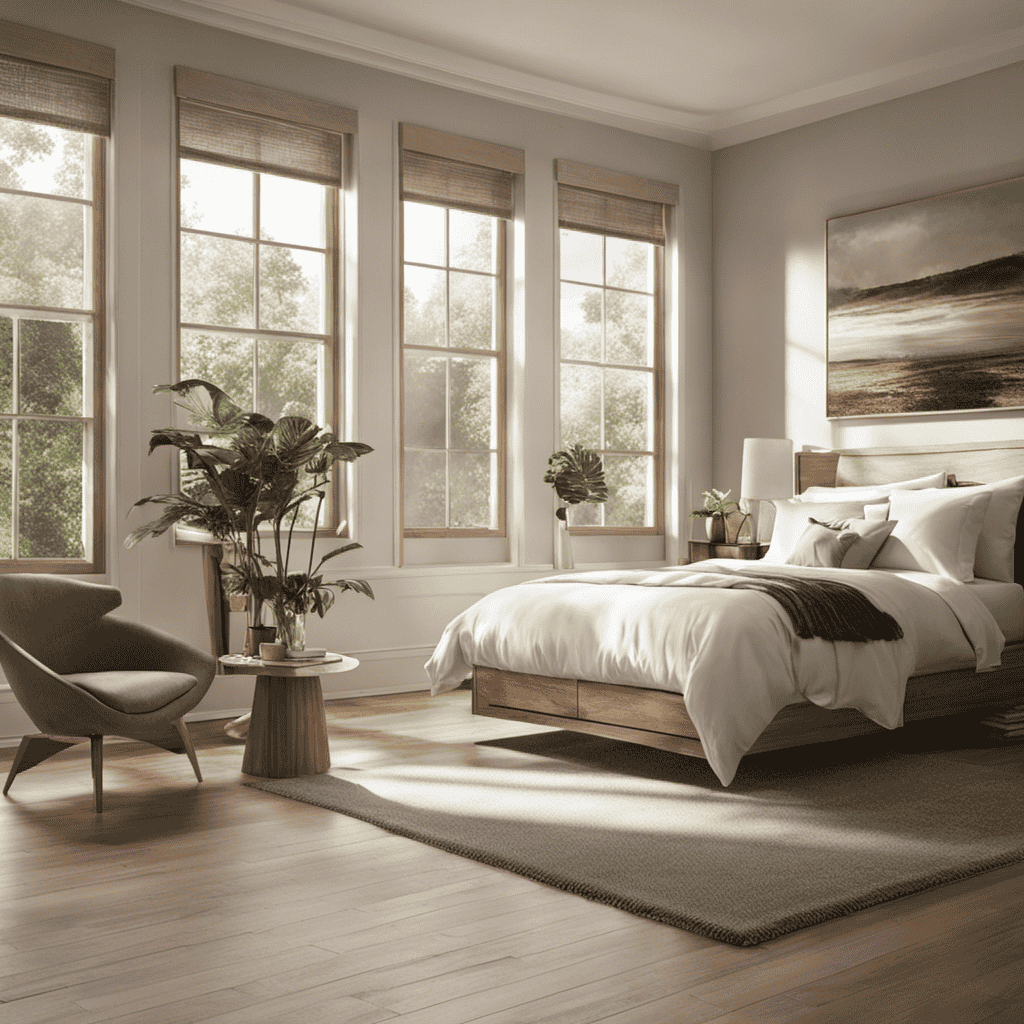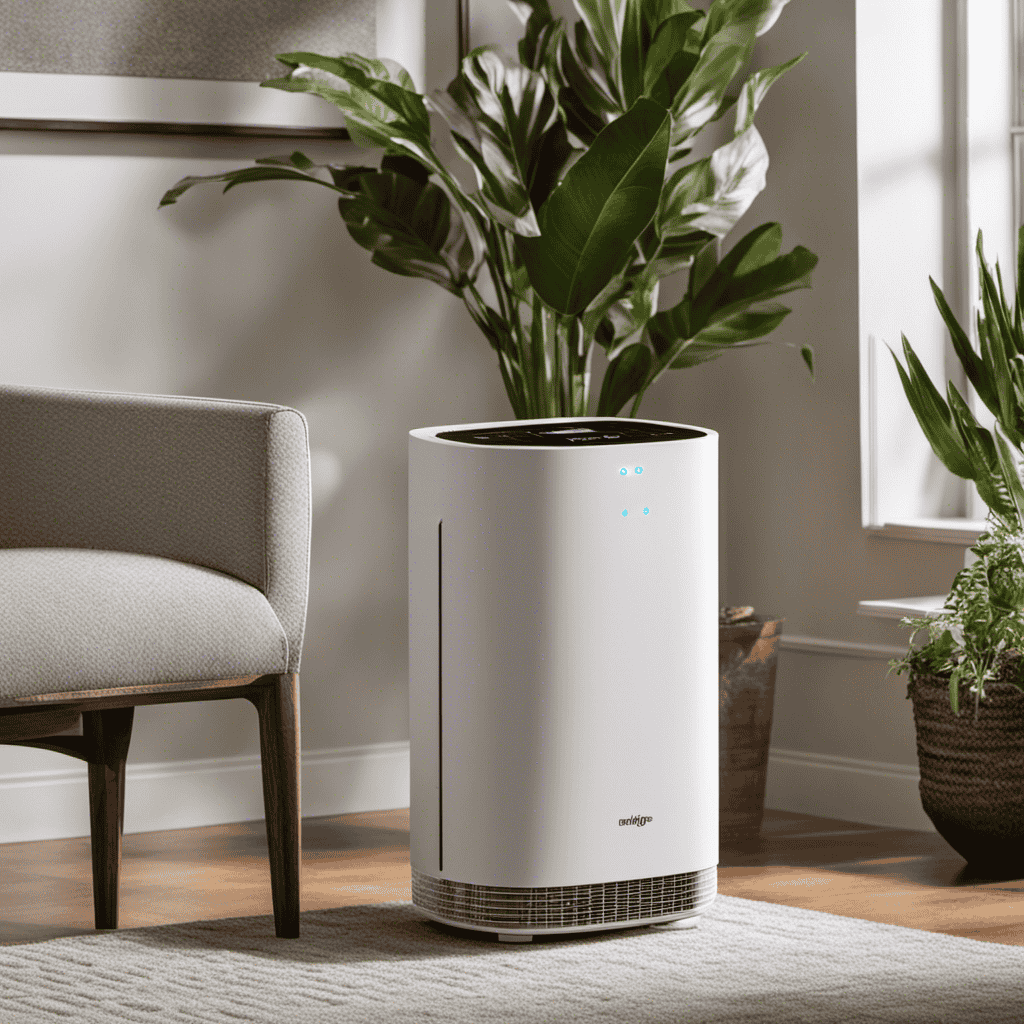Air purifiers focus on filtering out pollutants and allergens from your indoor air, not drying it out. Most models do not directly affect humidity levels, though some with humidifier or dehumidifier features can alter moisture. Generally, they won’t make your air drier. If you want to know how these devices impact humidity and what signs to watch for, keep exploring—there’s more to contemplate for comfortable indoor air.
Key Takeaways
- Most air purifiers do not significantly impact humidity; their primary function is filtering pollutants from the air.
- HEPA and activated carbon filters do not directly alter moisture levels during operation.
- Devices with humidification or dehumidification features can affect indoor humidity but are separate from standard purifiers.
- Air circulation from purifiers may help distribute moisture evenly but doesn’t dry out the air.
- Regular maintenance ensures effective filtration without unintended effects on indoor humidity.
How Do Air Purifiers Work?
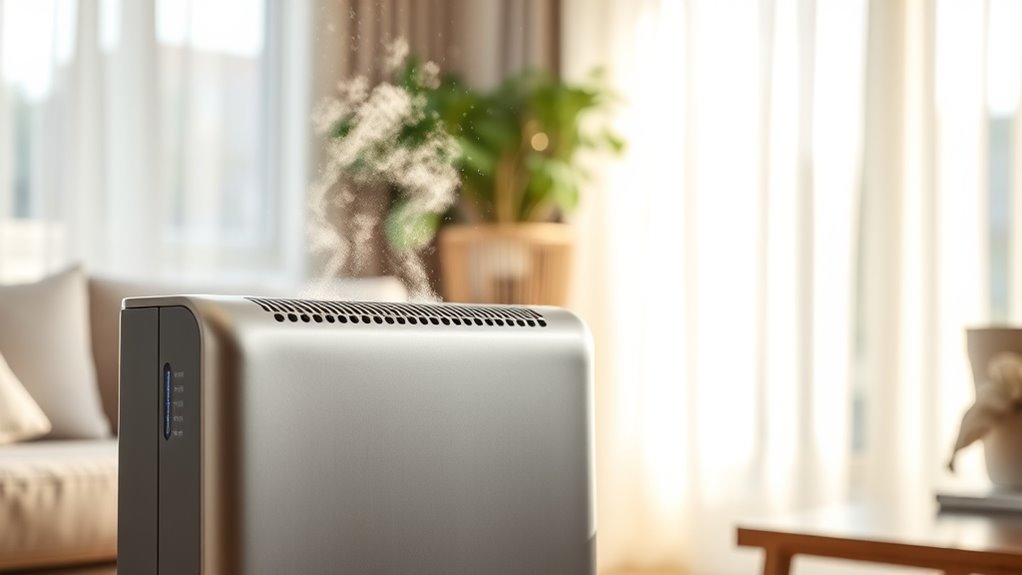
Air purifiers work by drawing in contaminated air and passing it through filters that trap pollutants. The core of this process is air purifier technology, which uses various filter types to remove particles like dust, pollen, and allergens. HEPA filters are common and highly effective at capturing tiny particles. As the air passes through these filters, pollutants are trapped, and clean air is released back into your space. To keep your air purifier functioning at its best, filter maintenance is essential; regular replacement or cleaning prevents clogging and maintains airflow efficiency. Some units also incorporate activated carbon filters to absorb odors and gases. Understanding how your air purifier works helps you ensure it runs effectively, providing cleaner air without impacting humidity levels. Additionally, modern air purifiers often include technology features that optimize their performance and energy efficiency. Regular filter replacement, typically every 6-12 months, is crucial for maintaining optimal air quality and ensuring the device continues to operate effectively. Properly maintaining filters and understanding the filter types used in your unit can extend its lifespan and improve overall air cleanliness. Being aware of potential malfunctions and troubleshooting common issues can also help maintain consistent performance. Furthermore, some models incorporate sensor technology to monitor air quality in real-time, allowing for automatic adjustments to filtration levels.
The Types of Air Purifiers and Their Effects on Humidity
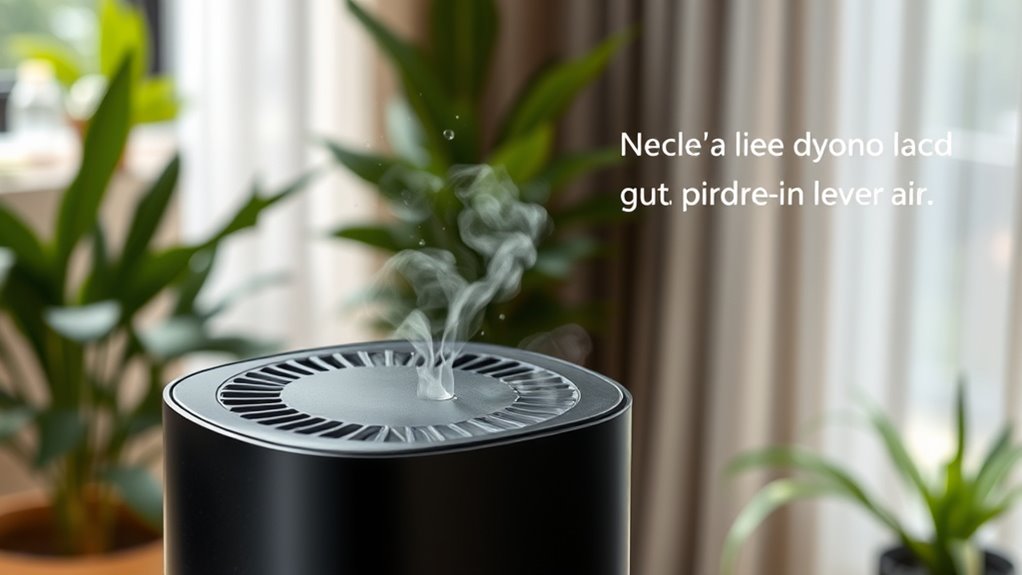
Different types of air purifiers can impact humidity levels in your space in various ways. Some models, like humidifier-compatible units, may add moisture, subtly increasing humidity. Others, especially those with dehumidifier effects, can reduce moisture levels, making the air drier. Understanding these differences helps you choose the right device for your needs. For example, HEPA filters improve air quality but don’t influence humidity directly. Activated carbon filters target odors without affecting moisture. Some advanced purifiers incorporate humidifier or dehumidifier features, blending air purification with humidity control. Be mindful of your space’s requirements: if you need to maintain specific humidity levels, select a purifier designed with either humidifier compatibility or dehumidifier effects in mind. This ensures ideal air quality without unintended dryness or excess moisture. Additionally, filter replacement indicators can help you monitor when to adjust or maintain your device to keep humidity levels balanced. To optimize both air quality and humidity, consider devices with integrated humidity sensors that adjust their functions automatically.
Do Air Purifiers Remove Moisture From the Air?
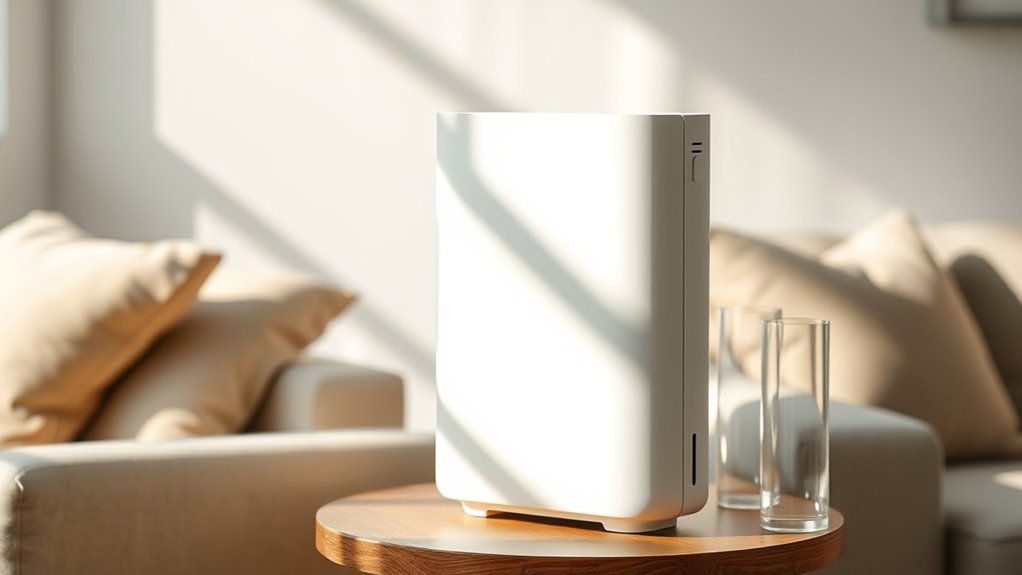
You might wonder if air purifiers also remove moisture from the air. While they focus on cleaning particles and pollutants, some models can impact humidity levels. Certain air purifiers, especially those with multi-functionality, may include features like humidification or dehumidification, which can affect moisture content in the air. Understanding their moisture removal mechanisms helps you choose the right device for your needs. Additionally, the technology used in some purifiers, such as HEPA filters, can influence how much moisture is affected during operation. It’s also helpful to consider advanced detection systems that monitor humidity levels and adjust operation accordingly.
Air Purifiers and Humidity
While air purifiers are designed to improve air quality by removing pollutants, many wonder if they also affect humidity levels. In general, standard purifiers don’t remove moisture from the air. However, devices like ozone generators and ionizers can raise concerns about moisture and air quality. Ozone generators produce ozone, which can interact with humidity, potentially causing dryness or irritation. Ionizers, on the other hand, may inadvertently trap moisture on surfaces, subtly impacting humidity. It’s important to note that most purifiers lack mechanisms for moisture removal, but some advanced units might influence humidity indirectly, especially those equipped with humidifying or dehumidifying features. Additionally, some air purifiers include air quality sensors that monitor humidity levels and can adjust operation accordingly. Understanding these nuances helps you choose the right device without worrying about drying out your environment. Furthermore, proper ventilation can help maintain balanced humidity levels in your space. Community feedback indicates that most users do not experience significant changes in humidity when using typical air purifiers.
Moisture Removal Mechanisms
Most air purifiers do not actively remove moisture from the air. Their moisture extraction capabilities are minimal, as they are designed mainly for air filtration, not humidity regulation. Some devices with activated carbon filters might absorb small amounts of moisture, but this isn’t their primary function. These purifiers focus on trapping airborne particles, allergens, and pollutants, rather than controlling humidity levels. If you’re concerned about dry air, using a humidifier is more effective than relying on an air purifier. In brief, air purifiers don’t substantially impact moisture levels, so they won’t dry out your air or lower humidity. Instead, they work alongside humidifiers or dehumidifiers if you need precise humidity regulation in your space. Additionally, understanding the moisture removal mechanisms can help you choose the right device for your needs. It’s important to recognize that most air purifiers are not designed to address humidity control, which is essential for maintaining comfortable indoor air quality. Recognizing the air filtration focus of these devices can prevent misconceptions about their role in humidity management.
Common Misconceptions About Air Purifiers and Dryness
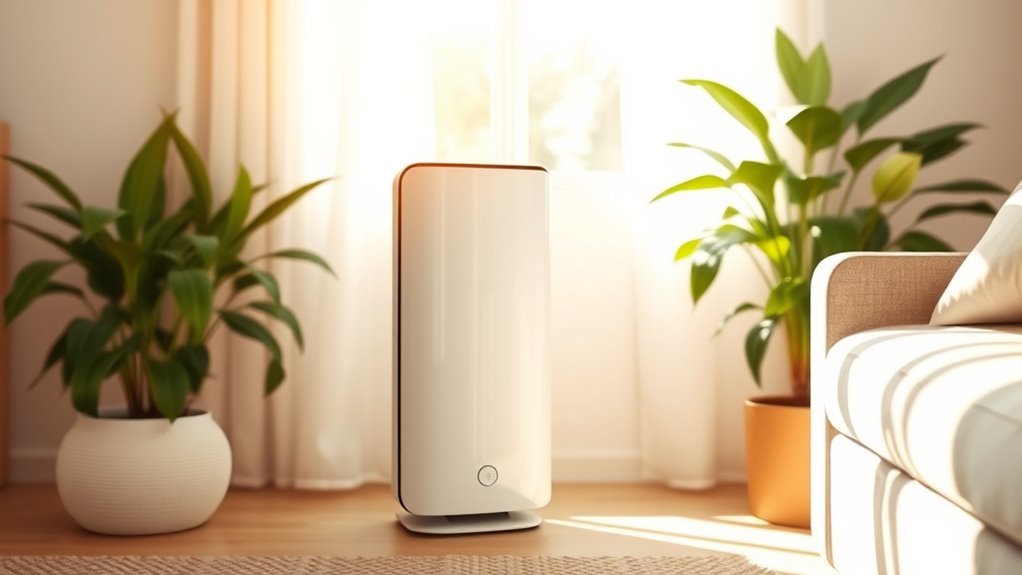
A common misconception is that air purifiers automatically cause dryness by removing too much moisture from the air. In reality, most units are designed to filter pollutants without substantially affecting humidity levels. Misunderstandings often stem from concerns about air purifier maintenance and noise levels, which can influence perceptions of their impact. For example, some believe continuous operation dries out the air, but proper maintenance ensures filters work efficiently without unnecessary dryness. Additionally, noise levels might lead you to think an air purifier is overly aggressive, yet modern models operate quietly and gently. Remember, air purifiers target airborne contaminants, not moisture, so dryness issues are usually unrelated to their function. Proper use and maintenance are key to avoiding misconceptions about their effects on humidity. Regular cleaning and filter replacement in accordance with manufacturer guidelines help maintain optimal performance without impacting humidity levels. Furthermore, understanding how air purifiers operate can help distinguish their actual effects from common myths about air quality and humidity. For example, some models include humidifying features, but these are designed to add moisture rather than remove it.
The Difference Between Filtration and Air Circulation

Understanding the difference between filtration and air circulation helps you choose the right device for your needs. Filtration traps particles, improving air quality, while circulation moves air to prevent stagnation. Both methods influence humidity levels differently, so knowing their roles can help you maintain a healthier home. Additionally, incorporating sound healing science principles can enhance overall well-being through mindful air quality management. Recognizing how air quality management strategies impact humidity can further optimize your home environment for comfort and health. Properly balancing these strategies can also minimize the risk of skin irritation caused by fluctuations in moisture levels. Being aware of humidification and dehumidification techniques can help you maintain ideal humidity levels and prevent issues such as dryness or mold growth. Understanding the subconscious power during sleep can also support your efforts to create a comfortable atmosphere that promotes restorative rest.
Filtration vs. Circulation
While air purifiers often combine filtration and circulation functions, it’s important to recognize that these two processes serve different purposes. Filtration traps particles using HEPA filters, UV sterilization, or carbon filters, reducing allergens, bacteria, and odors. Circulation, on the other hand, moves air throughout the space to ensure even distribution of clean air and prevent stagnation. Some devices use ozone generation to break down pollutants, but this can pose health risks if not managed properly. Understanding the distinction helps you choose the right purifier for your needs. Additionally, digital literacy plays a role in helping families select and maintain effective air purification systems tailored to their environment. Proper air flow management ensures optimal air quality and prevents issues like dry air or uneven humidity levels. Moreover, energy efficiency can influence how much a purifier impacts overall indoor humidity and comfort, especially with prolonged use. It’s also important to recognize that humidity control can be influenced by the type of purifier used and the overall ventilation, affecting indoor comfort and health.
Impact on Humidity
Although both filtration and air circulation influence indoor air quality, they affect humidity levels in different ways. Filtration primarily removes particles, which doesn’t markedly impact humidity directly. In contrast, air circulation can influence humidity regulation by distributing moisture evenly throughout a space. If your air purifier has dehumidifier effects, it might subtly reduce humidity by pulling moisture out of the air, but most standard units don’t. Proper air circulation can help prevent damp spots or overly dry areas, maintaining a balanced environment. Understanding this difference helps you choose the right device for your needs. While filtration improves air quality, managing humidity often requires a dedicated dehumidifier. Both strategies work together to create a healthier, more comfortable indoor climate.
Signs That Your Indoor Humidity Is Too Low
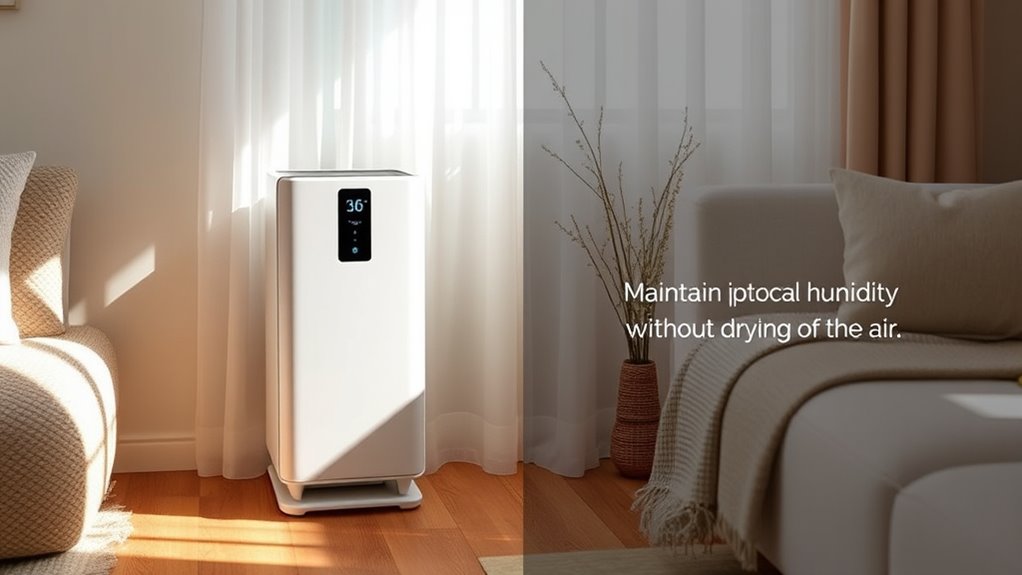
When your indoor humidity drops too low, you’ll notice certain signs that indicate your environment is too dry. You might experience increased static electricity, chapped skin, or irritated nasal passages. If you notice wooden furniture or musical instruments cracking, it’s a clear sign that moisture absorption is affecting your belongings. Additionally, dry eyes and a persistent sore throat are common indicators. Lack of humidity can hinder humidifier integration, making it harder to maintain proper moisture levels. Pay attention to these symptoms, as they signal your indoor air needs more moisture. Recognizing these signs early helps you address low humidity before it causes discomfort or damage. Keep an eye out for these indicators to ensure a comfortable, well-balanced environment.
Tips for Maintaining Proper Indoor Humidity Levels
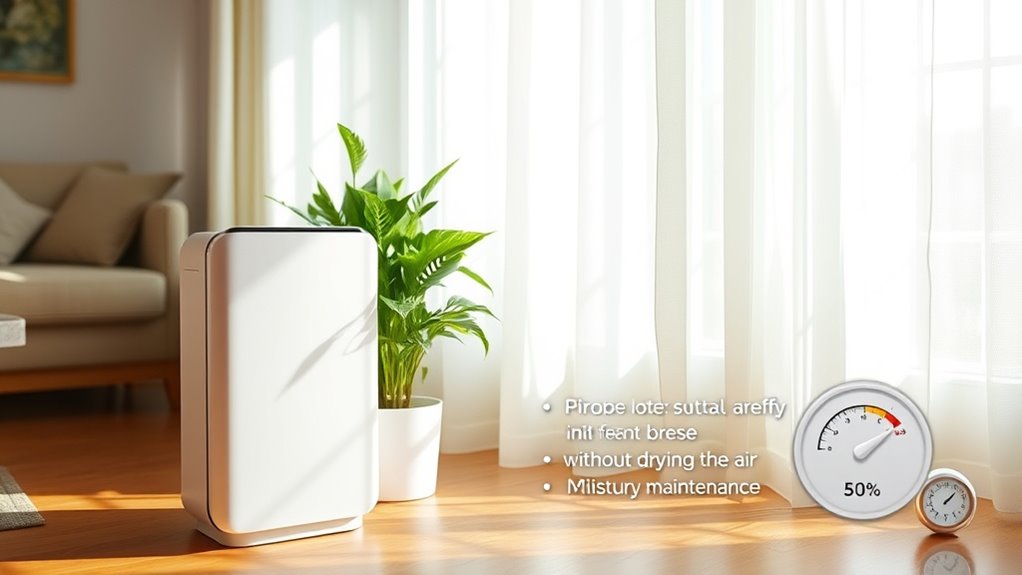
Maintaining proper indoor humidity levels is essential for comfort and health, and you can achieve this by using practical strategies. To maintain humidity balance, monitor your indoor levels regularly with a hygrometer. If the air feels dry, consider adding a humidifier to increase moisture; if it’s too humid, use a dehumidifier or improve ventilation. Proper humidity enhances air quality by preventing mold growth and reducing airborne allergens. Keep windows open when possible to promote airflow and reduce excess moisture. Avoid overusing heating or cooling systems that can dry out or overly humidify your space. Staying attentive to your indoor environment helps you sustain ideal humidity levels, which supports your overall well-being and improves air quality in your home.
Choosing the Right Air Purifier for Humidity Control

Choosing the right air purifier is essential for managing indoor humidity levels effectively. Look for models with humidifier compatibility to guarantee seamless integration with existing moisture control systems. Opt for units equipped with moisture sensing technology, which automatically adjusts operation based on the current humidity, preventing over-drying or excess moisture. Consider these factors:
- Compatibility with humidifiers or dehumidifiers
- Advanced moisture sensing features
- Adjustable humidity control settings
- Air purifier filtration efficiency
These features help maintain consistent humidity levels while improving air quality. Selecting an air purifier with these capabilities ensures you control humidity without risking dryness or excess moisture. Proper choice enhances comfort, protects your home, and supports overall health by maintaining optimal indoor conditions.
Frequently Asked Questions
Can Air Purifiers Help With Airborne Mold and Mildew Growth?
Air purifiers can help with airborne mold and mildew growth by filtering out mold spores, aiding mold prevention. However, they don’t directly regulate humidity levels. For effective humidity control and mold prevention, use a dehumidifier or ensure proper ventilation. Keep humidity below 60% to inhibit mold growth, and combine this with an air purifier to improve air quality and reduce mold-related health risks.
Do HEPA Filters Impact Indoor Humidity Levels?
Think of HEPA filters as watchdogs for your air, not water spies. They focus on capturing airborne particles, so they don’t directly impact humidity levels. While some air purifiers with humidity control features can help maintain a balanced environment, pure HEPA filtration doesn’t lower indoor humidity. You can enjoy cleaner air without worrying about drying out your space, as HEPA filters leave humidity untouched.
Are There Specific Air Purifiers Designed to Add Moisture?
Some air purifiers are designed with humidification technology, which adds moisture to the air rather than drying it out. If you’re looking to increase humidity, choose a device specifically built for moisture addition. These models combine air purification with humidification, helping to maintain comfortable indoor humidity levels. Be sure to check for features like built-in humidifiers to guarantee you’re getting an air purifier that supports your moisture needs.
How Do Air Purifiers Affect Indoor Allergy and Asthma Symptoms?
Did you know that using an air purifier can reduce airborne allergens by up to 99%? You might see clearer air and fewer allergy or asthma symptoms. Air purifier effectiveness depends on the device, but many help trap dust, pollen, and pet dander, providing allergy symptom relief. You’ll notice easier breathing and less congestion, making your indoor space more comfortable. Just verify your purifier is appropriately rated for your room size for maximum benefit.
Can Air Purifiers Improve Air Quality Without Affecting Humidity?
Air purifiers can improve your air quality without disturbing your humidity balance. They filter out pollutants, allergens, and dust without adding or removing moisture from the air. If you use a device with a humidifying or dehumidifying feature, it might affect humidity levels, but standard purifiers typically don’t. To maintain ideal indoor conditions, choose an air purifier designed to enhance air quality while preserving your desired humidity balance.
Conclusion
Remember, air purifiers are like silent guardians—they clean your air without stealing moisture. While they can help improve air quality, they usually don’t dry out your space. Keep an eye on your humidity levels, especially if your home feels like a desert, and consider a humidifier if needed. With the right setup, you’ll create a balanced oasis where fresh air and comfortable humidity dance in harmony.



